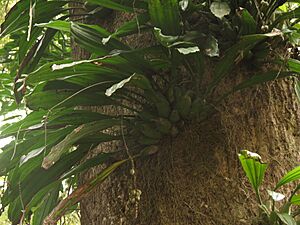Common rattlesnake orchid facts for kids
Quick facts for kids Common rattlesnake orchid |
|
|---|---|
 |
|
| Scientific classification | |
| Genus: |
Pholidota (plant)
|
| Species: |
imbricata
|
| Synonyms | |
|
Synonyms list
Cymbidium imbricatum (Lindl.) Roxb.
Coelogyne imbricata (Lindl.) Rchb.f. Ptilocnema bracteata D.Don Ornithidium imbricatum Wall. ex Lindl. Pholidota conchoidea Lindl. Pholidota calceata Rchb.f. Pholidota crotalina Rchb.f. Pholidota loricata Rchb.f. Pholidota triotos Rchb.f. Coelogyne conchoidea (Lindl.) Rchb.f. Coelogyne crotalina (Rchb.f.) Rchb.f. Coelogyne loricata (Rchb.f.) Rchb.f. Coelogyne triotos (Rchb.f.) Rchb.f. Pholidota assamica Regel Pholidota imbricata var. coriacea Hook.f. Pholidota imbricata var. longifolia Schltr. Pholidota imbricata var. montana Schltr. Pholidota imbricata var. platyphylla Schltr. Pholidota henryi Kraenzl. Pholidota beccarii Schltr. Pholidota grandis Kraenzl. Pholidota spectabilis Kraenzl. ex Guillaumin Pholidota imbricata var. henryi (Kraenzl.) Tang & F.T.Wang Pholidota bracteata (D.Don) Seidenf. |
|
The Pholidota imbricata, also known as the common rattlesnake orchid or necklace orchid, is a fascinating plant. It belongs to the orchid family. This orchid grows in clumps and can be found on trees or rocks. It has special swollen stems called pseudobulbs that store water. Each pseudobulb has one leathery leaf. The plant produces many small, cup-shaped flowers that are white, cream, or greenish. These flowers grow in two rows along a thin stem. A large, papery leaf-like part called a bract sits at the base of each flower. You can find this orchid in warm, wet areas from tropical and subtropical Asia all the way to the southwest Pacific.
What it Looks Like
The Pholidota imbricata is a herb that grows in clumps. It can live on other plants (an epiphyte) or on rocks (a lithophyte). Its crowded pseudobulbs, which are like thick stems, are about 8 to 12 centimeters (3 to 5 inches) long and 3 to 5 centimeters (1 to 2 inches) wide.
Each pseudobulb has a single, dark green leaf. The leaf is pleated and feels leathery. It can be 20 to 40 centimeters (8 to 16 inches) long and 6 to 8 centimeters (2 to 3 inches) wide. The leaf sits on a short stalk, about 5 centimeters (2 inches) long.
This orchid produces many flowers, usually between twenty and sixty of them. The flowers are cup-shaped and small, about 6 to 8 millimeters (0.2 to 0.3 inches) long. They can be white, cream, or greenish. They grow in two neat rows along a thin, wiry stem that is 15 to 40 centimeters (6 to 16 inches) long.
Each flower has a large, curved pinkish bract at its base. The top part of the flower, called the sepal, is about 4 to 5 millimeters long. The side sepals are a bit longer, about 6 to 7 millimeters. The petals are smaller, about 3 to 4 millimeters long. The special lower petal, called the labellum, is about 4 millimeters long and 5 millimeters wide. It's shaped like a cup and has three main parts, with the middle part further divided into three smaller sections. These orchids usually bloom between March and May.
Naming the Orchid
The scientific name Pholidota imbricata was first officially described in 1825. This was done by a person named William Jackson Hooker. He published his description in a book called Exotic Flora.
The second part of the name, imbricata, comes from a Latin word. It means "overlapping like roofing-tiles or shingles." This describes how the parts of the flower or pseudobulbs might overlap, just like tiles on a roof.
Where it Lives
The common rattlesnake orchid usually grows in warm, humid places like rainforests. It likes to attach itself to trees or rocks. Sometimes, it can be found in other damp, protected spots.
This amazing orchid is found in many different countries and regions. You can see it in China, India, Cambodia, Laos, Myanmar, Thailand, and Vietnam. It also grows on many islands, including Borneo, Java, the Philippines, Sumatra, and New Guinea. Further east, it's found in places like the Solomon Islands, Fiji, New Caledonia, and Vanuatu. In Australia, it grows on some Torres Strait Islands and in Queensland, as far south as Townsville.
See also
 In Spanish: Orquídea collar para niños
In Spanish: Orquídea collar para niños


